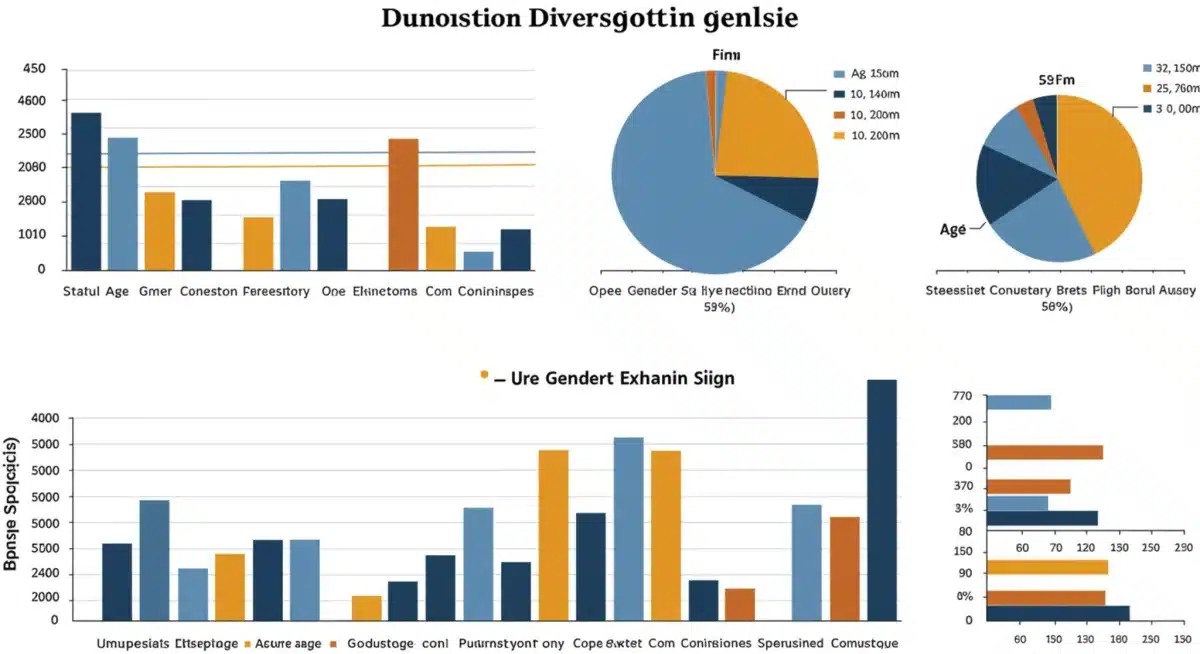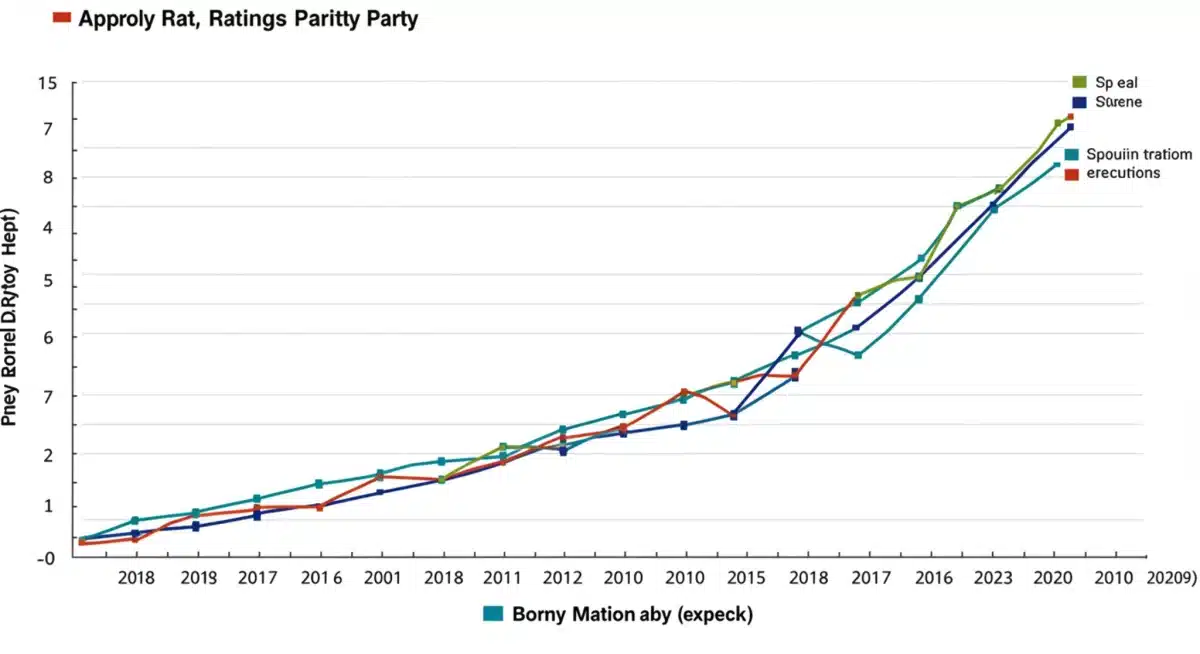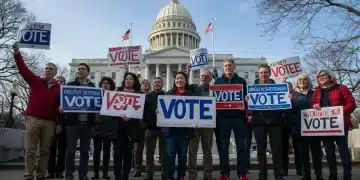Decoding Poll Numbers: Shifting US Political Landscape

Decoding poll numbers offers essential insights into the dynamic shifts within the US political landscape, reflecting voter sentiment and influencing strategic decisions in real-time.
In an era of constant information flow and evolving political dynamics, understanding how to interpret and analyze public opinion is more critical than ever. The act of decoding poll numbers has become an indispensable tool for journalists, political strategists, and the general public alike, offering a glimpse into the collective consciousness of the American electorate and the ever-shifting political landscape. These numbers, far from being mere statistics, tell a nuanced story of hopes, fears, and expectations that shape the future of the nation.
The Science and Art of Polling: Beyond the Surface
Public opinion polling is often perceived as a straightforward measure of public sentiment, but its methodology involves a complex interplay of science and art. The accuracy and reliability of poll numbers depend heavily on various factors, including sampling techniques, question wording, and the demographic representation of respondents. A deep understanding of these underlying mechanisms is crucial for anyone attempting to truly decode what the latest figures are telling us about the political climate.
Pollsters employ a range of methods to gather data, from traditional telephone surveys to modern online panels. Each method comes with its own set of advantages and limitations, influencing the final results. Understanding these nuances helps in assessing the credibility of different polls and in identifying potential biases that might skew their findings.
Sampling Methods and Their Impact
The foundation of any robust poll lies in its sampling method. A representative sample is paramount to ensure that the opinions gathered accurately reflect the broader population. Without proper representation, poll numbers can be misleading.
- Random Sampling: Every individual in the target population has an equal chance of being selected, minimizing bias.
- Stratified Sampling: The population is divided into subgroups (strata), and then random samples are drawn from each stratum, ensuring representation of diverse groups.
- Quota Sampling: Interviewers are given quotas for certain demographic characteristics, aiming to match the population’s proportions.
Each method has its strengths in capturing different facets of public opinion, but also its vulnerabilities to error. For example, random digit dialing can miss those who primarily use cell phones, while online panels might overrepresent more tech-savvy demographics. Recognizing these limitations is the first step in properly interpreting poll data.
The art comes into play when pollsters craft questions designed to elicit honest and unbiased responses. Subtle changes in wording can significantly alter how respondents interpret a question, leading to different answers. This is why critical analysis of questionnaires is as important as reviewing the raw data.
In conclusion, interpreting poll numbers requires more than just looking at percentages; it demands a critical examination of the methods used to collect those numbers. Only by understanding the science and art behind polling can we truly begin to decode their deeper meanings and implications for the political landscape.
Key Demographic Shifts and Their Political Resonance
The United States is a nation of diverse demographics, and understanding how different groups lean politically is fundamental to decoding poll numbers effectively. Shifts in the political allegiances of key demographic blocs can have profound implications for election outcomes and policy priorities. Analyzing these shifts allows us to anticipate emerging political trends and understand the evolving fabric of American society.
Recent polling data consistently highlights significant movements within various demographic groups. For instance, younger voters often exhibit different priorities and political leanings compared to older generations, influenced by distinct life experiences and economic realities. Similarly, racial and ethnic groups, as well as urban versus rural populations, frequently demonstrate unique patterns of political engagement and support.
Generational Divides in Voter Behavior
Generational cohorts, such as Millennials, Gen Z, Gen X, and Baby Boomers, represent distinct voting blocs with varying political preferences. These differences are often shaped by the defining historical moments they have experienced and their current socio-economic status.
- Gen Z and Millennials: Tend to be more liberal on social issues and prioritize climate change, student debt, and racial justice.
- Gen X: Often seen as a swing generation, balancing economic concerns with social progress.
- Baby Boomers: Generally more conservative, with a strong focus on economic stability and traditional values.
These generational divides are not static; political events and policy changes can cause shifts within these groups over time. For instance, economic downturns might push younger voters towards more progressive solutions, while national security concerns could sway older generations towards more established political figures.
Beyond age, factors such as education level, income bracket, and geographic location also play a crucial role in shaping political opinions. Voters in suburban areas might prioritize different issues than those in densely populated urban centers or sparsely populated rural communities. These distinctions are vital for political campaigns to understand when crafting their messages and strategies.

In summary, a thorough analysis of demographic shifts is indispensable for accurately interpreting poll numbers. These shifts reflect the dynamic nature of public opinion and provide valuable clues about the future direction of the country’s political landscape, requiring continuous monitoring and careful consideration.
The Influence of Current Events on Public Opinion
The political landscape is highly susceptible to the ebb and flow of current events. Major national and international developments can dramatically sway public opinion, leading to rapid shifts in poll numbers. Understanding this dynamic relationship is essential for accurately decoding poll numbers and predicting potential political trajectories. From economic crises to global conflicts, the headlines of today often dictate the political sentiments of tomorrow.
Recent history provides numerous examples of how unforeseen events have reshaped public perception and electoral prospects. A sudden economic downturn can erode confidence in the incumbent party, while a successful response to a national crisis can boost approval ratings. These reactions are not always rational; they are often deeply emotional and immediate, reflecting the public’s direct experience and anxieties.
Economic Conditions and Voter Sentiment
The state of the economy is consistently one of the most powerful drivers of public opinion. When the economy is robust, voters tend to be more optimistic and more likely to support the status quo. Conversely, periods of high inflation, unemployment, or recession often lead to widespread dissatisfaction and a desire for change.
- Inflation: Directly impacts household budgets, often leading to negative perceptions of economic management.
- Job Growth: A strong indicator of economic health, fostering optimism and stability.
- Market Performance: While not universally felt, a booming stock market can influence overall economic sentiment.
These economic indicators are closely watched by political strategists because they offer a clear window into the public’s mood. Polls that track consumer confidence and economic outlook are particularly valuable in this regard, providing leading indicators of how voters might behave in upcoming elections.
Beyond economics, social issues, environmental concerns, and geopolitical events also play significant roles. High-profile court decisions, debates over civil rights, or international conflicts can galvanize specific voter groups and alter the political narrative. The media’s portrayal of these events further amplifies their impact, shaping how the public perceives and reacts to them.
Ultimately, current events act as a powerful catalyst for change in public opinion. Any attempt to decode poll numbers without considering the prevailing socio-political and economic climate would be incomplete. It is the continuous interplay between events and public reaction that paints the most accurate picture of the shifting political landscape.
Understanding Polling Margins of Error and Confidence Levels
When encountering poll numbers, one of the most critical elements often overlooked is the margin of error. This statistical measure provides a range within which the true population value is likely to fall, offering a crucial layer of context for accurately decoding poll numbers. Without understanding the margin of error, one might draw incorrect conclusions from seemingly significant differences between candidates or issues.
The margin of error (MOE) is typically expressed as a plus or minus percentage point. For example, a poll reporting 50% support with a ±3% margin of error means the actual support could be anywhere between 47% and 53%. This range is vital, especially in close races, where a difference of a few percentage points might appear meaningful but could actually be within the statistical noise.
The Role of Confidence Levels
Closely related to the margin of error is the concept of confidence level, usually set at 95%. This means that if the same poll were conducted 100 times, the results would fall within the stated margin of error 95 times out of 100. It’s a statement about the reliability of the polling methodology, not a guarantee of absolute precision for any single poll.
- Higher Sample Size: Generally leads to a smaller margin of error, increasing precision.
- Population Variability: More diverse populations can sometimes lead to larger margins of error if not properly sampled.
- Desired Confidence: A higher confidence level (e.g., 99%) would require a larger margin of error for the same sample size.
It is important to remember that the margin of error only accounts for sampling error, not other potential sources of bias such as question wording, non-response bias, or issues with respondent honesty. These non-sampling errors can be far more difficult to quantify but can significantly impact a poll’s accuracy.
When comparing different polls, it’s also crucial to note if their margins of error overlap. If two candidates are polling at 48% and 45%, respectively, with a ±3% margin of error, their results are statistically indistinguishable. This is a common pitfall for casual observers who might interpret such a difference as a clear lead.
In essence, appreciating the margin of error and confidence levels transforms poll numbers from definitive statements into probabilistic estimates. This nuanced understanding is fundamental to sophisticated interpretation and is key to responsibly decoding poll numbers in a volatile political environment.
The Impact of Polling on Political Strategy and Campaigns
Poll numbers are not merely reflections of public opinion; they actively shape the strategies and narratives of political campaigns. For candidates, parties, and advocacy groups, decoding poll numbers is a continuous and iterative process that informs everything from message development to resource allocation. The insights derived from polling can determine which issues are emphasized, which demographics are targeted, and even where campaign events are held.
Campaigns often use a variety of polling types, including benchmark polls at the outset, tracking polls to monitor daily shifts, and exit polls on election day. Each type serves a distinct purpose in providing actionable intelligence. For instance, benchmark polls help identify a candidate’s strengths and weaknesses, while tracking polls allow for rapid adjustments to messaging in response to evolving public sentiment.
Targeting Voters and Resource Allocation
One of the primary uses of poll data is to identify key voter segments and allocate campaign resources efficiently. Understanding which demographics are undecided or persuadable allows campaigns to tailor their outreach efforts and invest in areas where they can have the greatest impact.
- Voter Segmentation: Identifying groups based on demographics, issue preferences, and past voting behavior.
- Message Crafting: Developing specific narratives and talking points that resonate with targeted segments.
- Geographic Focus: Directing advertising and ground game efforts to swing states or competitive districts.
This strategic use of data helps campaigns optimize their spending, ensuring that every dollar and every volunteer hour is leveraged for maximum effect. Without robust polling, campaigns would operate largely in the dark, relying on intuition rather than empirical evidence.
Polls also play a significant role in shaping media narratives. When a candidate’s numbers surge or dip, it becomes a major news story, influencing public perception and potentially creating a bandwagon effect or a sense of inevitability. This media coverage, in turn, can further impact voter behavior, creating a feedback loop between polls, media, and public opinion.

In conclusion, the strategic importance of polling in political campaigns cannot be overstated. By providing a data-driven understanding of the electorate, poll numbers enable campaigns to make informed decisions that can ultimately determine electoral success. The ongoing process of decoding poll numbers is thus integral to modern political warfare.
The Evolution of Polling in the Digital Age
The digital age has brought about both unprecedented opportunities and significant challenges for public opinion polling. The internet and mobile technologies have revolutionized how data is collected, processed, and disseminated, profoundly altering the landscape of decoding poll numbers. While offering faster results and potentially broader reach, these new methods also introduce new complexities and questions about accuracy and representation.
Traditional polling methods, such as landline telephone surveys, have seen a decline in effectiveness due to changing communication habits. The rise of cell phones, coupled with increased call screening and voicemail usage, has made it harder to reach a representative sample. In response, pollsters have increasingly turned to online surveys, text messaging, and even social media analysis to gauge public sentiment.
Challenges and Innovations in Digital Polling
While digital polling offers efficiency, it also presents unique challenges, particularly concerning self-selection bias and ensuring data quality. Not everyone has equal access to the internet, and those who choose to participate in online polls may not be representative of the general population.
- Online Panels: Recruit participants who agree to take surveys, often weighted to match demographic targets.
- Text Message Surveys: Offer a direct way to reach mobile users, but response rates can vary.
- Social Media Sentiment Analysis: Uses AI to analyze public discourse on platforms, providing qualitative insights but not necessarily representative quantitative data.
Innovations in data science and machine learning are helping to address some of these challenges. Pollsters are developing more sophisticated weighting techniques and predictive models to adjust for biases inherent in digital data collection. Hybrid approaches, combining elements of traditional and digital polling, are also becoming more common to enhance accuracy.
The speed at which digital polls can be conducted means that political narratives can shift almost instantaneously, creating a dynamic environment where rapid response is key. However, this speed also sometimes comes at the cost of thoroughness, leading to a proliferation of less rigorous polls that can confuse the public and distort understanding of the true political climate.
In conclusion, the evolution of polling in the digital age is a double-edged sword. While it offers exciting new tools for understanding public opinion, it also demands a more critical and informed approach to decoding poll numbers. The future of polling will likely involve a continuous adaptation to technological advancements, always striving for greater accuracy and representativeness in a rapidly changing world.
Beyond the Horse Race: What Polls Reveal About Policy Issues
While much of the public discourse around poll numbers centers on who is ahead in the ‘horse race’ of elections, their utility extends far beyond mere candidate popularity. Effectively decoding poll numbers can reveal profound insights into public sentiment on critical policy issues, offering a barometer for the nation’s priorities and concerns. This deeper analysis moves beyond simple approval ratings to understand the nuances of public support or opposition to specific legislative proposals and government actions.
Policy-focused polls delve into a wide array of topics, from healthcare reform and environmental regulations to economic policies and social justice initiatives. By dissecting these numbers, policymakers, advocates, and the public can gain a clearer picture of where consensus lies, where divisions are deepest, and which issues are gaining or losing traction among different segments of the population.
Public Opinion on Key Policy Areas
Understanding public opinion on policy is crucial for democratic governance. It helps elected officials gauge the mandate for their actions and adjust their platforms to better reflect the will of their constituents. This information is invaluable for both guiding legislative efforts and informing public debate.
- Healthcare: Polls often reveal strong opinions on access, cost, and the role of government in healthcare.
- Climate Change: Data can show evolving public concern, support for renewable energy, or skepticism about policy interventions.
- Immigration: Complex issue with diverse opinions on border security, pathways to citizenship, and economic impact.
These detailed insights allow for a more nuanced understanding of the political landscape than simply focusing on candidate approval. They highlight the underlying currents of public thought that often drive electoral decisions and shape the long-term direction of the country.
Furthermore, policy polling can identify emerging issues that may not yet be at the forefront of the national conversation but are gaining importance among specific demographics. This early detection allows for proactive engagement and policy development, rather than reactive responses to crises. It can also expose disconnects between public priorities and legislative agendas, highlighting areas where political representation might be failing.
In conclusion, looking beyond the electoral race and focusing on policy-specific poll numbers provides a richer, more comprehensive understanding of the political landscape. It offers vital clues about the direction the country is heading and the challenges and opportunities that lie ahead, making the nuanced process of decoding poll numbers an indispensable tool for informed citizenship and effective governance.
The Future of Political Polling: Adapting to New Realities
The landscape of political polling is in a constant state of flux, driven by technological advancements, shifts in human behavior, and an increasingly polarized political environment. The future of decoding poll numbers will depend heavily on the ability of pollsters to adapt to these new realities, innovate their methodologies, and restore public trust in their findings. The challenges are significant, but so are the opportunities for more accurate and insightful measurements of public opinion.
One of the most pressing challenges is the issue of declining response rates. As people become more wary of unsolicited calls and emails, engaging a representative sample has grown increasingly difficult. This necessitates creative approaches to outreach and incentives, as well as a greater reliance on advanced statistical modeling to correct for non-response bias.
Innovations in Data Collection and Analysis
The future will likely see a greater integration of diverse data sources, moving beyond traditional survey methods. This includes leveraging ‘big data’ from online behavior, social media, and even consumer habits, combined with sophisticated analytical tools.
- Passive Data Collection: Analyzing anonymized digital footprints to infer preferences and behaviors.
- Artificial Intelligence and Machine Learning: Used for predictive modeling, sentiment analysis, and identifying hidden patterns in vast datasets.
- Deliberative Polling: Combining traditional polling with informed discussion, aiming to measure more considered public opinion.
These innovations promise to provide a more holistic and real-time understanding of public sentiment, but they also raise important ethical questions regarding privacy and data security. The balance between insightful analysis and responsible data stewardship will be a critical aspect of future polling practices.
Another key aspect of the future will be the continued effort to combat misinformation and political polarization. Polls can sometimes be weaponized or misinterpreted to serve partisan agendas, eroding public confidence. Clearer communication about methodologies, limitations, and margins of error will be essential to foster greater transparency and trust.
In conclusion, the future of political polling is not about abandoning the practice, but about evolving it. By embracing new technologies, refining methodologies, and prioritizing transparency, pollsters can continue to provide invaluable insights into public opinion. The ongoing process of decoding poll numbers will remain a vital tool for understanding the shifting political landscape, helping to inform citizens and guide democratic decision-making in an ever-changing world.
| Key Aspect | Brief Description |
|---|---|
| Methodology Matters | Sampling, question wording, and data collection methods critically influence poll accuracy. |
| Demographic Shifts | Changes in generational, racial, and geographic voting patterns significantly alter outcomes. |
| Current Events Impact | Major news and economic conditions rapidly sway public opinion and poll numbers. |
| Margin of Error | Crucial for understanding the range of true support and statistical significance in results. |
Frequently Asked Questions About Political Polls
The accuracy of political polls varies depending on methodology, sample size, and transparency. While they provide a snapshot of public opinion, factors like margin of error, non-response bias, and question wording can influence results. Reputable polls often come with a stated margin of error and confidence level.
The margin of error indicates the range within which the true population value is likely to fall. For example, a poll at 50% with a ±3% margin of error means the actual support is likely between 47% and 53%. It accounts for sampling variability, but not all potential biases.
Differences in poll results can arise from varying methodologies, including sampling techniques, question wording, timing of the poll, and how ‘likely voters’ are defined. Each polling firm has its own approach, leading to natural variations in reported numbers. Comparing across multiple polls provides a more complete picture.
Major current events, such as economic shifts, natural disasters, or significant political developments, can rapidly alter public sentiment and, consequently, poll numbers. Voter opinions are often reactive to immediate circumstances, making recent events a powerful driver of short-term polling changes and long-term trends.
Polls are snapshots of public opinion at a specific moment, not definitive predictions. While they offer strong indicators, they cannot account for late-breaking events, voter turnout fluctuations, or unforeseen changes in sentiment. They are best used as tools to understand voter tendencies rather than as crystal balls for election results.
Conclusion
Decoding poll numbers is far more than a statistical exercise; it’s an intricate process of understanding the heartbeat of a nation’s political consciousness. From the foundational methodologies that underpin their creation to the dynamic influence of current events and evolving demographics, polls offer invaluable insights into the shifting political landscape. While not without their limitations and complexities, when interpreted with a critical eye and informed perspective, they remain an essential compass for navigating the intricate world of American politics. As technology advances and societal norms change, the art and science of polling will continue to evolve, striving to provide the clearest possible reflection of public sentiment and the forces shaping our collective future.





